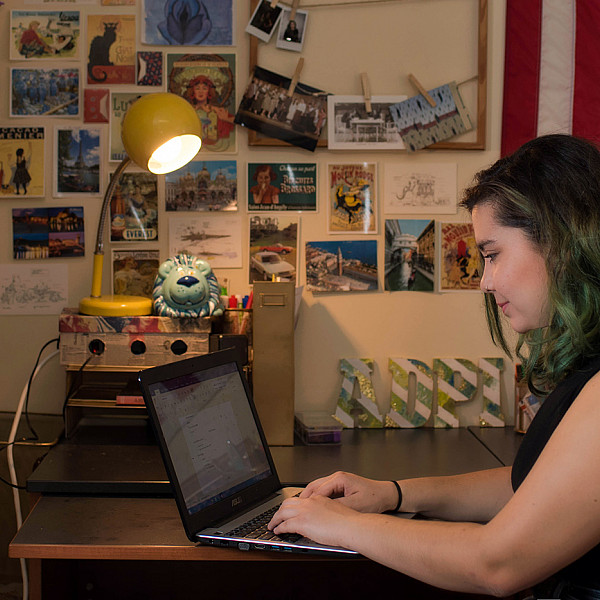News
A Change for the Better
October 06, 2020
October 06, 2020
Open gallery

The decision to leave your current institution of learning and enter a new one can be daunting. The questions that arise while deliberating this life-altering choice can be numerous and perplexing: How do I know if my current institution isn’t right for me? How do I decide where I want to transfer to? Where do I even begin?
Personally, I recognized that my previous university wasn’t right for me when I began to dread going to class every day. There was no excitement in my studies, I felt out of place and awkward while on campus, and I had no personal attachment to the school. At that point, I was only there for the diploma and a class ring. I resolved to power through it, telling myself if I tried harder, I could find my niche, but the harder I tried, the more unhappy I was. The more school organizations I joined, the more disinterested I was in taking part in campus life. The farther I advanced in my degree, the less certain I felt in my choice of study. Most of all, the longer I stayed, the more insecure I became about my abilities as a student, future employee, and person. No matter how much effort I put in, I was still convinced that I was underperforming and insufficient.
After a particularly rough day in my first semester as a sophomore, I decided enough was enough, and I began my plans to transfer to a new university. I won’t lie: it took a lot of planning and work. However, when all was said and done, I knew I had made the right choice.
The following recommendations are words I wish someone had said to me before I began the process of transferring universities. My hope is that these words will make their way to an individual who finds themselves in the same situation as I once was and that I can provide guidance, encouragement, or, at the very least, reassurance regarding the transfer process.
Determine where you want to go, but if you’re undecided, don’t panic
You can’t expect to determine which institution is best suited for you and your priorities without doing a little, or a lot, of research. Based on your decision to leave your current university, it is likely you already have a notion of what you don’t want at your new university. In my case, I knew I didn’t want my classes to have more than 30 students, so I understood that a smaller private school would be my best option. Look at components such as the number of students attending the school, the structure of the curriculum, and the values that the university community prioritizes. After you discern these preferences, you’ll possess a basic overview of your ideal university.
However, if the time to leave your current university arrives and you’re still pondering your options, I would recommend enrolling in a different temporary learning institution until you make a permanent decision. Luckily, there are numerous community colleges and other institutions that are well suited for this purpose. Survey the community colleges around you, or research online schools that offer classes compatible with your area of study. If you do go this route, you’ll be able to complete your entry-level courses, stay on track to complete your degree on time, reflect on your ambitions, and plan accordingly.
Prepare your transcripts
Once you’ve narrowed your search to specific colleges, convert all your transcripts from high school and current or previous colleges to a format that can be easily printed or emailed. Many schools use conversion programs or catalogues that indicate how your credits from your previous university will transfer. If you have these documents prepared beforehand, you’ll be able to establish the requirements you have already satisfied and the courses you still need to take. If you can complete this step prior to enrollment, you can plan ahead and register for classes at your current university that you are positive will transfer over.
Visit your top universities
Next, contact the admissions office of each school you’re interested in. Often, there will be an individual specifically designated to aiding transfer students in the process of switching schools. At Southwestern University, this individual is Director of Transfer Recruitment Scott Sandoval. After some initial correspondence, I was able to schedule an appointment to meet with him and discuss my options. Thanks to this session, I amassed a plethora of valuable information I otherwise would not have possessed while considering which university would be the best candidate to advance my education.
Keep in close contact with the people assisting you in your journey
People want to help you, especially those at small, tight-knit communities such as Southwestern. My initial exposure to the university was through a friend of a friend who offered to meet me at 309 Coffee, the preferred study and hangout spot of SU students. This meeting was a crucial factor in my final decision. While gathering a wide array of information from university websites and other online accounts, it is arguably even more important to identify the general atmosphere of the school. Considering you will be spending substantial amounts of time on this campus for at least the next couple of years, one of your primary concerns should be ensuring it’s an environment you can enjoy on a day-to-day basis. Consulting with a student who has interacted with the school and its community for an extended period of time can be paramount in deciding whether this school, in respect to the social climate, is the right fit for you.
If you aren’t directly acquainted with a student of the university, then consult your friends, family, and other connections. However, if all else fails, social media is an ideal method for gathering genuine opinions. But don’t just browse the school’s main social-media pages; search out the accounts dedicated to other affiliated groups, such as alumni and parents of students. By doing this, you will be able to gather an array of alternative opinions from various sources rather than from just the school’s marketing department.
In addition, maintain communication with the office designated to transfer student admissions. In the case of Southwestern University, the Office of Admission is crucial in your journey to becoming a student. Specifically, Scott Sandoval will be your saving grace while navigating the ins and outs of the transfer process. Personally, without the help of Sandoval and other individuals in the Office of Admission, my transfer experience would likely have been considerably more unpleasant.
Following my admission to the school, I was continuously supported by many of Southwestern’s staff and faculty, including Associate Professor of Economics and Business Debika Sihi, my Sprog orientation adviser (Sprog is an event all new students attend to orient themselves with the campus and prepare for their first semester at Southwestern), as well as Director of Business Internships and Assistant Professor of Business Andy Ross, who is currently my academic advisor. Both have been integral to my success at Southwestern. In my experience, Dr. Sihi is always prepared to deliver a warm hug and encouraging words of wisdom while Professor Ross has been a continuous source of support in my academic and professional endeavors, even when I’ve doubted myself.
At Southwestern, you can’t throw a stone without hitting someone willing to dedicate time and energy to support you in any way possible. This is the benefit of connecting with a community devoted to its students, their well-being, and their success.
Take it one step at a time
When I resolved to transfer universities, I was overwhelmed. Not only was I simultaneously managing classes, a job, and other responsibilities I had at the time, but I was also attempting to meet deadlines related to my transfer. Unfortunately, stress of this sort is inevitable and unavoidable. However, there are certain measures you can take to keep your head above water and prevent the loss of your sanity.
In my experience, I found that taking everything one step at a time was critical to ensuring I didn’t overload myself. At the beginning of my venture, I devised a list of all the tasks necessary to complete, such as visiting schools, applying to said schools, and following through with the actions necessary to transferring. Following this, I split each task into bite-sized, manageable pieces I could tackle one at a time. After this list was complete, it was merely a matter of following it until I came out the other side a proud Southwestern Pirate.
College should be a time when you can try anything and everything, be allowed to stumble, fall, and fail without dire consequences, and have life-changing experiences you can cherish for the rest of your life.
Ultimately, college shouldn’t be a four-year-long burden to bear until you graduate and can finally start your “real life.” Real life is now. This should be a time when you can try anything and everything, be allowed to stumble, fall, and fail without dire consequences, and have life-changing experiences you can cherish for the rest of your life. Whichever school you choose to attend, ensure it’s one you’re thrilled to be at and passionate to be a part of.
The saying “choose a job you love, and you will never have to work a day in your life” is absolutely applicable to education. If you choose your school wisely, learning will not be a chore but a pleasure. Find a school that inspires joy. If you do this, you can be confident that your leap of faith will come to fruition and the manifestation of your efforts will follow close behind. So eradicate any feelings of self-doubt, and trust that you have the capability to accomplish what is necessary to create a future suited to an exceptional individual such as yourself. Best of luck on your journey!
















